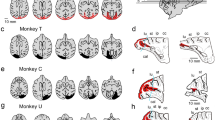Abstract
In humans lesions of right visuoparietal cortex induce a neglect of the contralesional visual field that is characterized in its mild form by inattentiveness to objects and events and, in its more severe form, by a condition that has many features that are indistinguishable from blindness. Here we show that spatial neglect can be induced in cats by lesions of posterior and inferior visuoparietal cortex, and that the lesion-induced neglect can be cancelled by cooling deactivation of the same region in the opposite hemisphere.

Similar content being viewed by others
References
Cowey A, Walsh V (2001) Tickling the brain: studying visual sensation, perception and cognition by transcranial magnetic stimulation. Prog Brain Res 134:411–425
Hardy SC, Stein BE (1988) Small lateral suprasylvian cortex lesions produce visual neglect and decreased visual activity in the superior colliculus. J Comp Neurol 273:527–542
Hilgetag CC, Kötter R, Young MP (1999) Inter-hemispheric competition of sub-cortical structures is a crucial mechanism in paradoxical lesion effects and spatial neglect. Prog Brain Res 121:121–141
Kapur N (1996) Paradoxical functional facilitation in brain-behaviour research. A critical review. Brain 119:1775–1790
Lomber SG (2001) Behavioral cartography of visual functions in cat parietal cortex: areal and laminar dissociations. Prog Brain Res 134:265–284
Lomber SG, Payne BR (1996) Removal of two halves restores the whole: reversal of visual hemineglect during bilateral cortical or collicular inactivation in the cat. Vis Neurosci 13:1143–1156
Lomber SG, Payne BR, Cornwell P, Long KD (1996) Perceptual and cognitive visual functions of parietal and temporal cortices in the cat. Cereb Cortex 6:673–695
Lomber SG, Payne BR, Horel JA (1999) The cryoloop: an adaptable reversible cooling deactivation method for behavioral or electrophysiological assessment of neural function. J Neurosci Methods 86:179–194
Lynch JC, McLaren JW (1989) Deficits of visual attention and saccadic eye movements after lesions of parietooccipital cortex in monkeys. J Neurophysiol 61:74–90
Oliveri M, Rossini PM, Traversa R, Cicinelli P, Filippi MM, Pasqualetti P, Tomaiuolo F, Caltagirone C (1999) Left frontal transcranial magnetic stimulation reduces contralesional extinction in patients with unilateral right brain damage. Brain 122:1731–1739
Oliveri M, Bisiach E, Brighina F, Piazza A, La Bua V, Buffa D, Fierro B (2001) rTMS of the unaffected hemisphere transiently reduces contralesional visuospatial hemineglect. Neurology 57:1338–1340
Pascual-Leone A, Davey N, Rothwell J, Wasserman E, Puri BK (2002) Handbook of transcranial magnetic stimulation. Oxford University Press, Oxford
Payne BR, Lomber SG (1999) A method to assess the functional impact of cerebral connections on target populations of neurons. J Neurosci Methods 86:195–208
Payne BR, Lomber SG (2002) The use of cooling deactivation to reveal the neural basis of lesion-induced plasticity in the developing and mature brain. In: Lomber SG, Galuske RAW (eds) Virtual lesions. Oxford University Press, Oxford, pp 163–188
Payne BR, Lomber SG, Geeraerts S, Van der Gucht E, Vandenbussche E (1996) Reversible visual hemineglect. Proc Natl Acad Sci U S A 93:290–294
Sherman SM (1977) The effect of superior colliculus lesions upon the visual fields of cats with cortical ablations. J Comp Neurol 172:211–229
Sprague JM (1966) Interaction of cortex and superior colliculus in mediation of visually guided behavior in the cat. Science 153:1544–1547
Sprague JM (1996) Neural mechanisms of visual orienting responses. Prog Brain Res 112:1–15
Taub E, Uswatte G, Elbert T (2002) New treatments in neurorehabilitation founded on basic research. Nat Rev Neurosci 3:228–236
Vanduffel W, Payne BR, Lomber SG, Orban GA (1997) Functional impact of cerebral connections. Proc Natl Acad Sci U S A 94:7617–7620
Vuilleumier P, Hester D, Assal G, Regli F (1996) Unilateral spatial neglect recovery after sequential strokes. Neurology 46:184–189
Watson RT, Valenstein E, Day A, Heilman KM (1994) Posterior neocortical systems subserving awareness and neglect. Neglect associated with superior temporal sulcus but not area 7 lesions. Arch Neurol 51:1014–1021
Acknowledgements
The work was supported by the National Institute for Neurological Disease and Stroke.
Author information
Authors and Affiliations
Corresponding author
Rights and permissions
About this article
Cite this article
Payne, B.R., Lomber, S.G., Rushmore, R.J. et al. Cancellation of visuoparietal lesion-induced spatial neglect. Exp Brain Res 150, 395–398 (2003). https://doi.org/10.1007/s00221-003-1473-x
Received:
Accepted:
Published:
Issue Date:
DOI: https://doi.org/10.1007/s00221-003-1473-x




